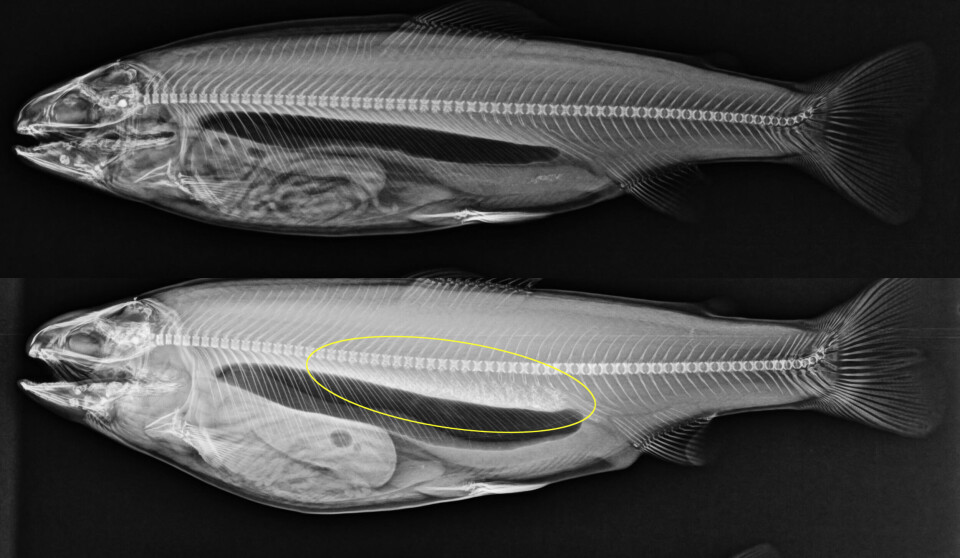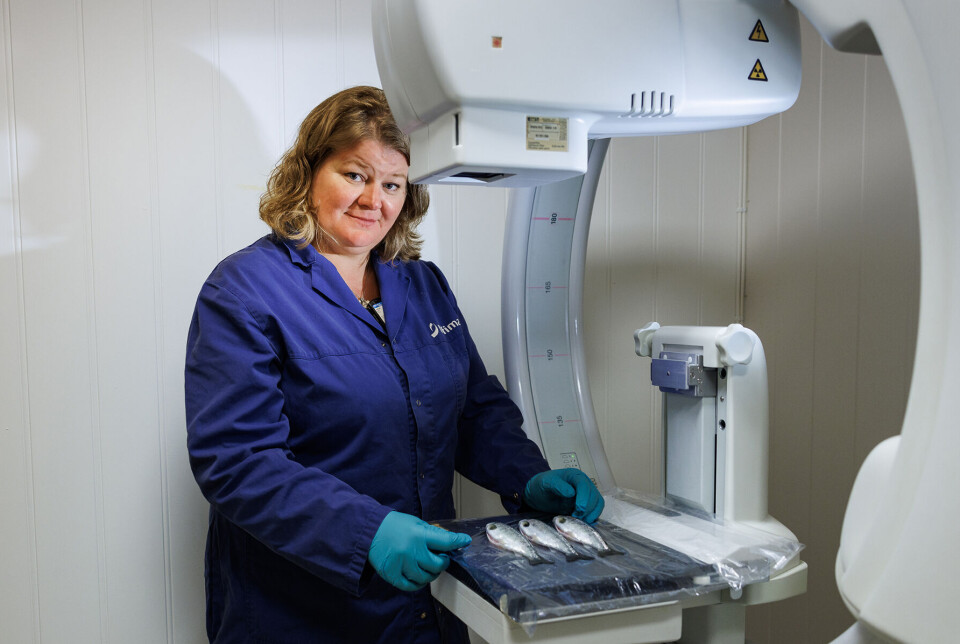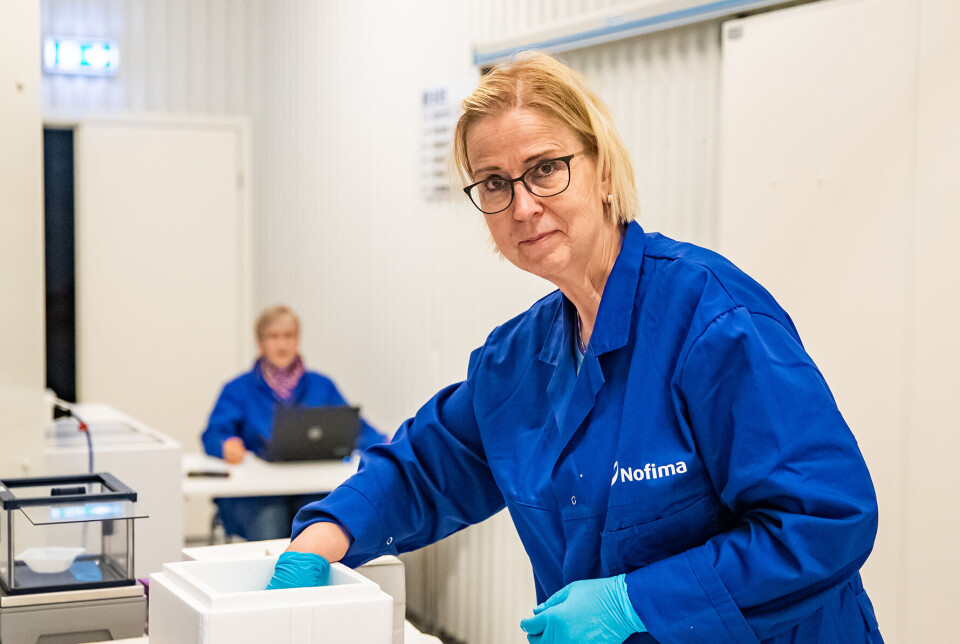THIS CONTENT IS BROUGHT TO YOU BY Nofima The Norwegian Institute of Food, Fisheries and Aquaculture Research - read more
Researchers have found the cause of kidney stones in rainbow trout
They investigated the effect of carbon dioxide levels in the water, and the results show a clear connection.

Juvenile fish are young fish released to grow until they reach slaughter size. Researchers have now found that the higher the concentration of carbon dioxide (CO2) in the water during the juvenile stage, the greater the proportion of fish that develop kidney stones, also known as nephrocalcinosis.
There is also a clear correlation between the concentration of CO2 and the severity of the condition.
Why is there carbon dioxide in the water?
During the juvenile stage, rainbow trout and salmon are farmed in tanks with freshwater on land. If the fish density is high and water exchange is low, the level of carbon dioxide increases.
As the fish breathe, they absorb oxygen through their gills and release carbon dioxide. In practice, there is therefore always some carbon dioxide in the water in a farming tank.
It is important to keep the concentration low enough not to harm the fish. Nofima has research that provides answers.
"May look perfectly healthy on the outside but have destroyed kidneys”
Nephrocalcinosis is a rapidly growing kidney disease in farmed salmonids. The kidneys are supposed to purify the blood and are one of the fish’s largest blood-forming and immunological organs.
Smolts with damaged kidneys struggle when they are transferred to the sea, even though carbon dioxide levels are low.
“It's uncertain how painful it is and when it becomes truly serious. The fish may look perfectly healthy on the outside but have destroyed kidneys,” says veterinarian Kirsti Hjelde at Nofima.
She has been involved in further developing X-ray diagnostics that allow kidney stones to be detected in live fish.

It has long been assumed that carbon dioxide affects the development of kidney stones, and a general recommendation to fish farmers has been to keep carbon dioxide below 15 milligrams per litre of water in juvenile fish facilities. However, this recommendation has not been well documented.
Nofima’s research now shows that 13 milligrams of CO2 per litre of water causes 5 per cent of the rainbow trout to develop kidney stones. When the fish were farmed in water with 26 milligrams of CO2 per litre, more than 40 per cent developed kidney stones.
“Our results show that CO2 values of 13 milligrams per litre and above increase the risk of nephrocalcinosis in rainbow trout,” says Ingrid Lein at Nofima.
The extent and severity of kidney stones rise steadily as the concentration of CO2 increases. Lein is careful to point out that she does not believe carbon dioxide is the only cause of kidney stones in rainbow trout, but that it is clearly a very important factor.
“For salmon, we know the situation is more complex, but there's every reason to believe that carbon dioxide is also an important part of the causal picture for salmon,” she says.
---

The method is the key to more knowledge
Behind the concrete results from the research lies method development that began as part of CtrlAQUA (a Centre for Research-based Innovation (SFI)) a few years ago. Nofima has now further developed the method through experiments at the research station in Sunndalsøra, Norway.

“We now have a model system where we can induce nephrocalcinosis in rainbow trout and measure the effect on the fish. With this setup, it becomes easier to investigate other risk factors, interactions and measures against kidney stones in farmed fish,” says André Meriac at Nofima.
He hopes the aquaculture industry will dig deeper into the causes of nephrocalcinosis and is ready to help clarify causes and contribute to healthier farmed salmon in commercial facilities.
X-rays measure the effect
To measure the effect of various treatments, Nofima uses X-rays on live fish on a large scale. With X-rays on live fish, scientists can detect the kidney stones, which are crystals in the kidneys. Previously, diagnostics were limited to taking tissue samples and the need to kill the fish to study the kidneys.
“With X-rays, we avoid harming the fish. In this experiment, we took live X-rays of all individuals before they were transferred to sea and will take new X-rays at the end of the experiment to understand how the different treatments during the juvenile stage have affected how the fish coped in the sea,” says Hjelde.

The research is funded by the Norwegian Seafood Research Fund (FHF) and is a collaboration between Nofima and several industry partners in aquaculture.

This content is paid for and presented by Nofima The Norwegian Institute of Food, Fisheries and Aquaculture Research
This content is created by Nofima's communication staff, who use this platform to communicate science and share results from research with the public. Nofima is one of more than 80 owners of ScienceNorway.no. Read more here.
More content from Nofima:
-
Pumpkins are good for more than just Halloween decorations
-
This is how temperature affects a salmon's health and growth
-
Study: Omega-3 and zinc is a powerful duo for salmon
-
Fish may turn yellow if frozen too fresh
-
Is it better if food is packaged in plastic or paperboard?
-
Researchers make healthy salmon feed from polluting CO₂




































